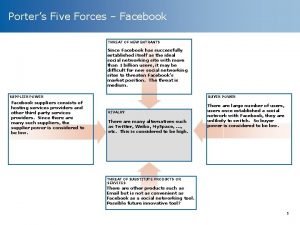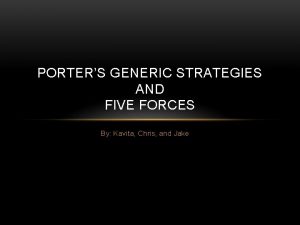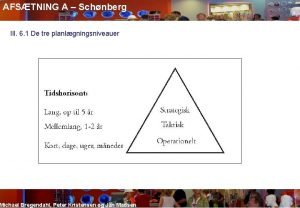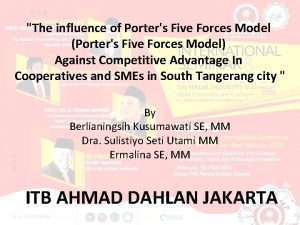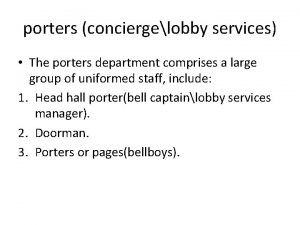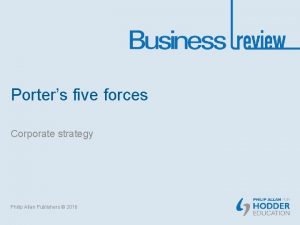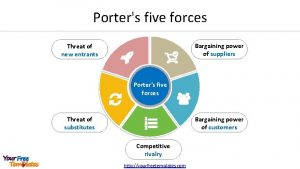Porters five forces Understanding the Five Forces Porters











- Slides: 11

Porter’s five forces

Understanding the Five Forces Porter's five Forces Porter regarded understanding both the competitive forces and the overall industry structure as crucial for effective strategic decision-making. In Porter's model, the five forces that shape industry competition are: ● Competitive Rivalry examines how intense the competition currently is in the marketplace, which is determined by the number of existing competitors and what each is capable of doing. Rivalry competition is high when there are just a few businesses equally selling a product or service, when the industry is growing and when consumers can easily switch to a competitor's offering for little cost. When rivalry competition is high, advertising and price wars can ensue, which can hurt a business's bottom line. (Competition, 2018)

Example of COMPETITIVE r. IVALRY Under Armour faces intense competition from Nike, Adidas and newer players. Nike and Adidas, which have considerably larger resources at their disposal, are making a play within the performance apparel market to gain market share in this up-and-coming product category. Under Armour does not hold any fabric or process patents, and hence its product portfolio could be copied in the future. (Competition, 2018).

Bargaining power of suppliers analyzes how much power a business's supplier has and how much control it has over the potential to raise its prices, which, in turn, would lower a business's profitability. In addition, it looks at the number of suppliers available: The fewer there are, the more power they have. Businesses are in a better position when there a multitude of suppliers. (Competition, 2018).

EXAMPLE OF b. ARGAINING POWER OF SUPPLIERS A diverse supplier base limits bargaining power. Under Armour's products are produced by dozens of manufacturers located across multiple countries. (Competition, 2018).

Bargaining power of customers looks at the power of the consumer to affect pricing and quality. Consumers have power when there aren't many of them, but lots of sellers, as well as when it is easy to switch from one business's products or services to another. Buying power is low when consumers purchase products in small amounts and the seller's product is very different from any of its competitors. (Competition, 2018)

EXAMPLE OF BARGAINING POWER OF CUSTOMERS Under Armour's customers include both wholesale customers as well as end customers. Wholesale customers, like Dick's Sporting Goods and the Sports Authority, hold a certain degree of bargaining leverage, as they could substitute Under Armour's products with those of competitors to gain higher margins. Bargaining power of end customers is lower as Under Armour enjoys strong brand recognition. (Competition, 2018).

Threat of substitution This is the likelihood of a customer finding a different way of doing what a business does (mindtools. com, 2018). For example, if a company supplies unique software to automate an important process, people may substitute it by doing the process manually, or by outsourcing it. A substitution that is easy and cheap, which is beneficial for the customer, may weaken the position a business holds, and ultimately this threatens profitability.

(Vistaprint. co. uk, 2018)

Threat of new entry The position of a business can be affected by the people’s ability to enter the market (mindtools. com, 2018). Such as how easy to get a foothold in the industry or market, how much would it cost, and how tightly is it regulated? Whether it takes little money and effort to enter the market, and compete. Protection of key technologies, competitors can weaken the position a busienss holds. The barriers for entry

References https: //www. vistaprint. co. uk/businesscards/standard? coupon. Autoload=1&GP=02%2 f 23%2 f 2018+04%3 a 52%3 a 50&GPS=4869714450&GNF=0 https: //www. mindtools. com/pages/article/new. TMC_08. htm Competition, P. (2018). Porter's Five Forces: Analyzing the Competition. [online] Business News Daily. Available at: https: //www. businessnewsdaily. com/5446 -porters-five-forces. html [Accessed 23 Feb. 2018].
 Porters five forces intern eller ekstern
Porters five forces intern eller ekstern Facebook porter five forces
Facebook porter five forces Porters five generic strategies
Porters five generic strategies Porter's generic business strategies
Porter's generic business strategies Les attitudes de porter
Les attitudes de porter Processmodellering verktyg
Processmodellering verktyg Det strategiske smil
Det strategiske smil Porters 3 generic strategy
Porters 3 generic strategy Porter's generic strategies
Porter's generic strategies Markedsstrategi 4 p
Markedsstrategi 4 p Dsv mening
Dsv mening Porters generiske strategier
Porters generiske strategier

